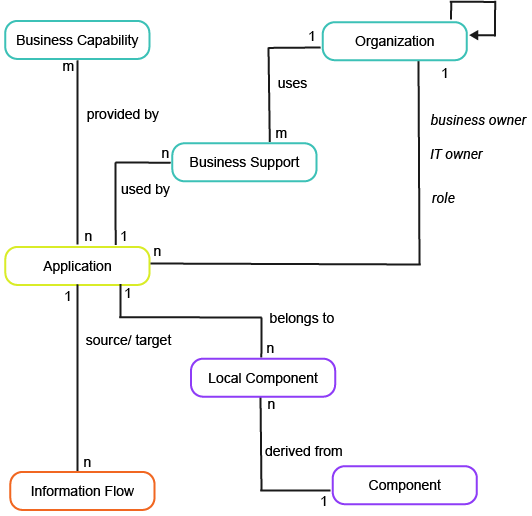Data requirements for "What are our investment and retirement candidates?"
This business question focuses on applications on multiple dimensions in the context of a TIME ( Tolerate, Invest, Migrate, Eliminate) quadrant.

To have meaningful data for the business question What are our investment and retirement candidates?, you must capture the following information about the applications , business capabilities , organizations , application groups , information flows , and components in your company.
| Class | Attribute | Mandatory | Explanation |
|---|---|---|---|
|
Application |
|||
|
Name |
Necessary for the visualization. |
||
|
Version |
Necessary for the visualization. |
||
|
Start Date |
x |
The start date contributes to the technical score of the application. |
|
|
Recommendation |
x |
The strategic recommendation regarding future investment for the application. Possible values are:
|
|
|
Architecture Type |
x |
The architecture type of the application: Possible values are:
|
|
|
Development Type |
x |
The application development type.
|
|
|
Number of Users |
x |
Indicator specifying the number users of the application. Contributes to the application's business score.
|
|
|
Software License Cost Software Maintenance Cost Infrastructure Cost Service Cost OpEx Other |
x (all) |
The application's current year total operational expenditure (OpEx) is defined as the sum of the application costs for the current year. |
|
|
Business Owner and IT Owner |
x |
The roles business owner and IT owner must be specified for either a person or organization for an application. |
|
|
(Using) Organization |
x |
The number of organizations using the application. Contributes to the business score. |
|
|
Business Capability |
|||
|
Level ID |
The hierarchical number of the business capability in the business capability hierarchy. For example: 1, 1.1, 1.1.1, 1.2, 1.2.1, etc. |
||
|
Name |
Necessary for the visualization |
||
|
Business Relevance |
x |
Indicates how relevant the business capability is for the business. Contributes to the business score.
|
|
|
Application |
x |
Application providing the business capability |
|
|
Information Flow |
|||
|
Object State |
Describes the operational status of the information flow. Information flows with a retired object state are ignored. |
||
|
Source Application > Target Application |
x |
An information flow requires an application that is the source and target of the connection. The number of information flows for which the application is the source or target contributes to the technical score. |
|
|
Local Component |
|||
|
Application |
x |
The local component associates the component it is derived from with the application it belongs to. |
|
|
Component |
The component that the local component is derived from. |
||
|
Component |
|||
|
Object State |
Describes the operational status of the component. Components with a retired object state are ignored. |
||
|
Lifecycle |
x |
The earliest end date of the lifecycle phase Manufacturer Extended Support of all components assigned to applications via local component is used to calculate the Vendor Support Lifespan indicator. The Vendor Support Lifespan indicator contributes to the technical score. |
|